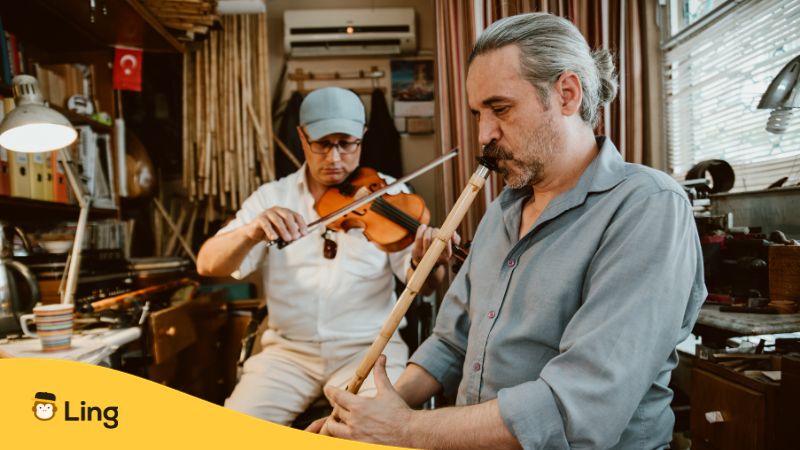Music is a universal language that transcends borders and cultures. And one of the topics that we would like to talk about when we learn a new language is music. More so because Turkish music is a rich reflection of melodies, rhythms, and traditions that have evolved over centuries. It is a perfect blend of Eastern and Western influences.
Whether they be the haunting notes of the Turkish flute “ney” or the vibrant sounds of the “bağlama”, Turkish music is a melodious amalgamation of the diverse cultural heritage of this nation. So in this article, you will get an intro to Turkish music and learn the common words about music in Turkish.
Introduction To Turkish Music
The history of Turkish music dates back centuries, with roots deeply embedded in the ancient Anatolian civilizations. From the Hittites to the Phrygians, music has always played a vital role in Turkish culture. These early civilizations used various instruments like the lyre and flute for religious and ceremonial purposes.
The Influence Of The Ottoman Empire
The Ottoman Empire, which ruled over vast territories, left an indelible mark on Turkish music. During this period, court musicians, known as “Ottoman Classical Music,” played a crucial role in shaping the musical landscape. “Ud”, “ney”, and “kanun” were some of the popular instruments used in the songs of Ottomans.
In fact, even though in modern Turkish we say “müzik”, the word for music in Ottoman Turkish is “musiki”.

Traditional Turkish Music
One of the defining characteristics of Turkish music is the concept of “makam.” Makam is a unique system of melodic modes that give Turkish music its distinct flavor. Each makam evokes different emotions, making Turkish music a truly expressive art form.
Traditional Turkish Musical Instruments
Traditional Turkish music is known for its wide array of instruments, each with its own unique sound. The “saz”, a long-necked lute, and the “darbuka”, a goblet drum, are just a couple of examples. These instruments are often used in folk music, connecting modern Turks with their cultural roots.
Kanun: The kanun is a traditional string instrument similar to a zither. It consists of many strings stretched across a trapezoidal wooden frame. Musicians play it by plucking the strings with their fingers or using picks.
Bağlama: The bağlama is a Turkish stringed musical instrument, commonly used in folk music. It has three double strings and is played with a pick or plectrum.
Zurna: The zurna is a traditional woodwind instrument, often used in Turkish and Balkan music. It has a loud, piercing sound and is typically made of wood or metal.
Kemençe: The kemençe is a bowed string instrument, similar to a small violin. It is played with a bow and has a distinct, resonant sound.
Ud (Oud): The ud, also known as the oud, is a pear-shaped, fretless string instrument. It is a staple in Middle Eastern music and is played by plucking the strings with the fingers.
Kaval (Shepherd’s Flute): The kaval is a simple, wooden flute with six finger holes. It is commonly used in folk music and has a sweet, pastoral sound.
Tef (Tambourine): The tef is a small hand-held drum with jingles or cymbals attached to the rim. It is played by shaking or tapping the drumhead with the hand.
Davul: The davul is a large, double-headed drum with a deep, booming sound. It is often used in traditional Turkish and Middle Eastern music, as well as in festive occasions.
Tulum: Tulum is a traditional Turkish bagpipe made of sheepskin. It consists of a bag and a chanter with finger holes. Musicians blow air into the bag and play melodies on the chanter.
Ney: The ney is an ancient wind instrument, typically made of reed. It has seven finger holes and is played by blowing air into the instrument while covering and uncovering the holes to produce different notes. The ney is often associated with Sufi music and meditation.
Words About Music In Turkish
Here is a vocabulary list of words related to music in Turkish with their translations:
Modern Turkish Music
In recent decades, Turkish music has undergone a transformation, blending traditional elements with Western influences. Pop, rock, and electronic music have become increasingly popular, creating a fusion of sounds that resonates with a younger generation.

Iconic Turkish Musicians
Turkey has produced a plethora of musical talents that have gained international recognition. Names like Sezen Aksu, Tarkan, Sertab Erener, Hadise and Manga have not only conquered the popular Turkish music scene but have also made their mark on the global stage.
Modern Musical Instruments In Turkish
In conclusion, Turkish music is a tapestry of tradition and innovation, deeply rooted in history while embracing the modern world. Its ability to captivate audiences and evoke emotions is a testament to its enduring appeal. From the mystical sounds of the East to the energetic beats of the West, Turkish music continues to enchant and inspire.
FAQs About Turkish Music
1. What are some famous Turkish musical instruments?
Some famous Turkish musical instruments include the “saz”, “darbuka”, “ney”, and “kanun”.
2. How has Turkish music evolved over the years?
Turkish music has evolved by incorporating Western influences and embracing various genres like pop and rock.
3. What is the “makam” in Turkish music?
Makam is a system of melodic modes that gives Turkish music its distinct character and emotional depth.
4. Can you recommend some iconic Turkish musicians to listen to?
Sure! You should check out Sezen Aksu, Tarkan, and Sertab Erener for a taste of Turkish music.
5. How is music celebrated in Turkish culture?
Music is celebrated in Turkish culture through various festivals, weddings, and everyday life, where it’s an integral part of gatherings and celebrations.
Start Learning Turkish With Ling!
Ready to embark on a journey of learning Turkish from scratch? Look no further than Ling!
Ling is your go-to language learning app, designed to ignite the passion for mastering a new language. Our app offers a wide range of interactive exercises, including writing, listening, mini quizzes, and an AI chatbot to refine your speaking skills. Ling equips you with everything you need to excel in all four essential language skills.
Don’t hesitate any longer. Experience Ling for FREE today by simply downloading it from the App Store or Play Store!
And don’t forget to explore Ling’s Turkish blog for daily insights into the Turkish language and culture.
Until next time! Görüşürüz!



































































